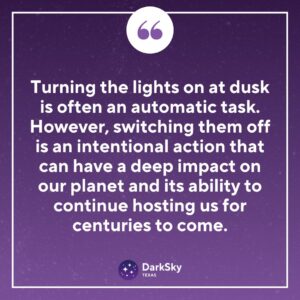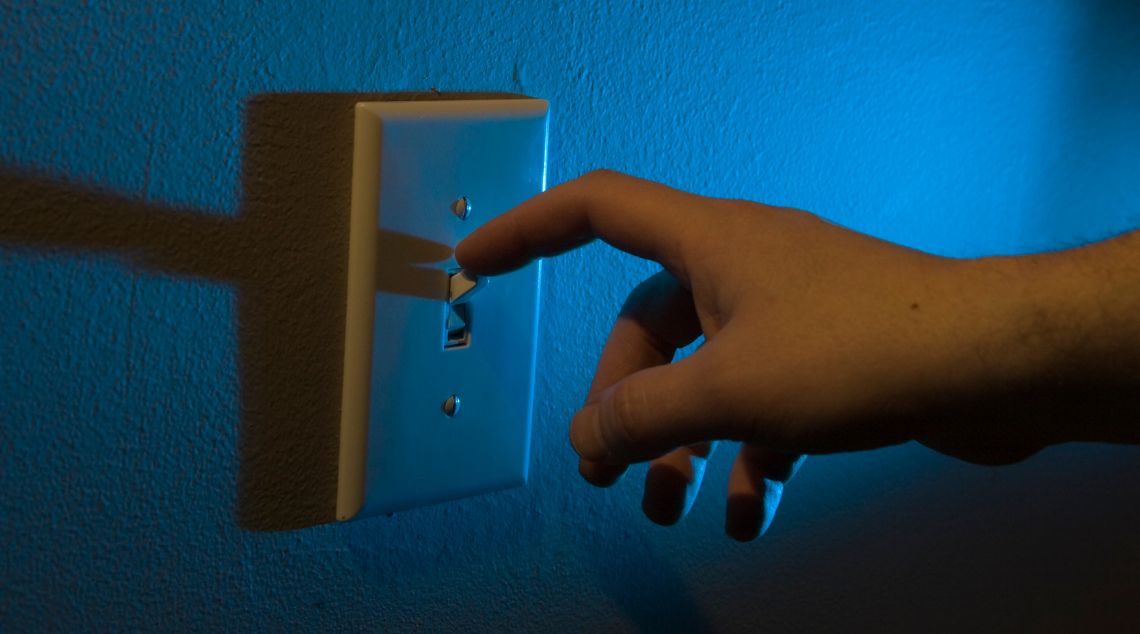Over the past thirty or more years, conservation organizations have asked Texans to help preserve the unique landscapes that our State has been blessed with. So many Texans boast about “The stars at night are big and bright” but we are losing the ability to brag about that. At DarkSky Texas, we have made it our goal to deepen everyone’s access to pristine nocturnal environments while still having the lights humans need to see and be safe. This is why we are always excited to have any opportunity to invite people to think about how they use outdoor lights – and whether some smart tweaks can have a much deeper impact than you’d think.
Outdoor Lights and the Environment: What’s the Connection?
This post considers the fourth of the Five Principles of Responsible Outdoor Lighting: Use light only WHEN it is needed. Even “useful” lights will not be needed at all times. Whenever possible, ensure the lights an be turned off when nobody’s around to use them.
Turning the lights on at dusk is often an automatic task. However, switching them off is often an intentional action that can deeply impact our planet and its ability to continue hosting us for centuries to come.
What we ask of you is simple: just give an equal amount of thought to both actions. By managing your outdoor lights responsibly, you can bring a positive impact to the following issues:

Energy efficiency
Rethinking your use of outdoor lights will decrease your energy consumption and the electricity bill attached to it.
For many of us, the cost of each light bulb appears minimal—but only until we start adding them up. In Texas, the standard electricity rate is 12 cents per kilowatt. On average, a two-bedroom home will need 30 light bulbs to stay “well lit” at night, which can cost up to $5.2 per day.
It may not seem much, but once we do the math, this becomes $156 per month, or $1,872 a year – and that’s enough for a nice vacation!
Mental health
We are designed to sync our sleep schedules, moods, and even appetite to specific times of the day based on the amount of light around us. At dusk, our bodies start to create more melatonin, a hormone that tells us the time for rest is fast approaching. Production of melatonin should increase to a peak during the hours of darkness then taper off towards morning.
Excess man-made lighting can make the skies look milky gray, purple or light blue instead of black around sparkling stars. As a result, our bodies no longer produce melatonin in the right amounts or at the right times – which can increase the likelihood of anything from stress to insomnia, heart disease, or diabetes.
Biodiversity
We are not the only species that relies on natural light cycles to find our footing. Animals and plants also use light levels to find their way home, predict seasonal changes, know when to rest, or locate their next meal. So what happens when nights are not as dark as they’re supposed to be? Or when multiple bright “moons” shine around their natural habitats all night? Confusion. With devastating consequences. By turning outdoor lights off, we can help our local species thrive.
Light Pollution FAQs: Are All Lights Made Equal?
The idea of going back to complete night darkness is not realistic. Instead, we can focus on minimizing our development’s impact on the surrounding skies.
In this sense, not all lights are made equal.
Do solar lights cause light pollution?
Solar lights, like the one’s used to highlight a walkway or garden bed, impact light pollution just like regular outdoor lights. The 5 Principles of Responsible Outdoor Lighting apply to solar lights too.
Consider having a timer to control when your solar lights are energized. Only turn them on when people will be out there using them. The health of the plants and living things around that walkway or in that garden is dependent on having natural daylight during the day and natural darkness during the night.
Do LED lights reduce light pollution?
LED lights are now renowned for being remarkably energy-efficient, which allows us to illuminate wider areas for less money. However, this doesn’t improve light pollution – and in some ways, it may worsen it.
LED lights often create a larger amount of “blue light.” It’s this blue light that makes LEDs appear very white to us. This light travels further than regular red or yellow lights and affects melatonin production more than other lighting for humans and animals.
Looking to Curb Light Pollution in Your Community? Support our Mission!
At DarkSky Texas, we are committed to nurturing a new generation of activists who will help us better lights for better nights. To do this, we host year-round educational events and work with city leaders and landowners to promote smarter and less disruptive outdoor lighting installations.
None of this would be possible without our supporter’s donations and contributions. Join our cause here.


